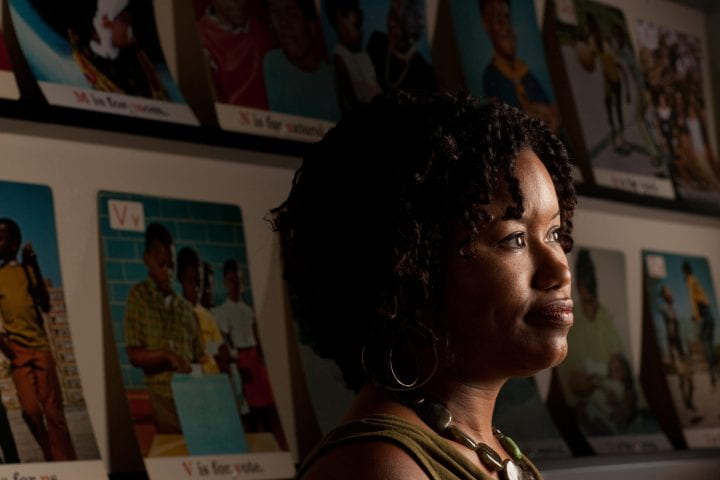Out of the shadows
Bridget Cooks sheds light on African American art, cultural imagery.

While browsing in a San Francisco school supply shop, Bridget Cooks came across a telling piece of African American history. “The Black ABC’s” was a relic of the early 1970s consisting of placards for every letter of the alphabet, each accompanied by a corresponding word and an image reflecting black culture.
The series is at times lighthearted – N is for “natural,” with a photo of young boys sporting Afro hairstyles – and faintly political – V is for “vote,” with a picture of children lining up at a ballot box for a school election. Cooks cherishes the set because it captures a period that overlapped her own childhood.
“At the time, it was important to place value on black, working-class people,” says the UC Irvine associate professor of art history and African American studies. “If it were done today, it would probably have a multicultural theme.”
Today, all 26 placards line a wall in Cooks’ Humanities Gateway office. She and her sister skillfully re-created a few missing ones with photos from her family album, such as one depicting her bell-bottom-clad cousins and another of her father, a former history teacher, standing at the blackboard in his East Los Angeles classroom.
Black images in art and culture are the focus of Cooks’ research and scholarly activities. She has curated several exhibitions of African American art at Santa Clara University’s de Saisset Museum and, most recently, “The Art of Richard Mayhew” at San Francisco’s Museum of the African Diaspora.
Her soon-to-be-released book, Exhibiting Blackness: African Americans and the American Art Museum, examines the representation of African American culture in mainstream art museums from the 1920s to the 2000s and chronicles the challenges black artists faced in getting their work shown.
“The museum and fine-art world can be an exclusive, elitist place,” Cooks says, citing a 1969 exhibit at New York’s Metropolitan Museum of Art called “Harlem on My Mind.” It featured photographic blowups and slides, videotapes and recordings but – for the first time in the institute’s history – not a single painting.
African Americans protested, and the show was skipped by The New York Times’ senior art critic. “Painters and printmakers from Harlem felt incredibly insulted by the omission,” Cooks says. “But it inspired black artists and others in the community to get more involved with museums and the curating profession.”
While completing her dissertation in 2002, Cooks worked as an educator at the Los Angeles County Museum of Art for four years and served as a liaison between the institute and various community groups, such as the elderly, teachers and children.
She recently returned to the museum as a panelist in a program entitled “Two Centuries of Black American Art: A 35th Anniversary Roundtable.” The event celebrated a groundbreaking LACMA exhibit that was among the first to recognize the contributions of African Americans.
The 1976 show included paintings by Richard Mayhew, who employs delicate pastels and deep purples to render landscapes that flow into abstract shapes. Cooks is an expert on the contemporary artist, calling him “one of the greats.”
She met Mayhew in 2006 – just before coming to UCI – at the de Saisset Museum, where she was teaching art history and ethnic studies. He asked her to curate his 2009-10 retrospective at the Museum of the African Diaspora, in the Bay Area.
“Mayhew refers to much of his work as ‘moodscapes’ because of its ability to move viewers toward a particular feeling,” Cooks says. “His response to social turmoil has consistently been to find a sense of peace and perspective through abstraction.”
Today, she says, the state of African American art is as varied as the state of African Americans, marked by both success and short-sighted failure.
“There has been no steady progression in the way museums and cultural institutions interact with black artists,” Cooks says. “As a scholar and curator, I’m part of a community that engages in critical practices to work toward institutional change – which happens through teaching and helping position artists to reach wider audiences.”